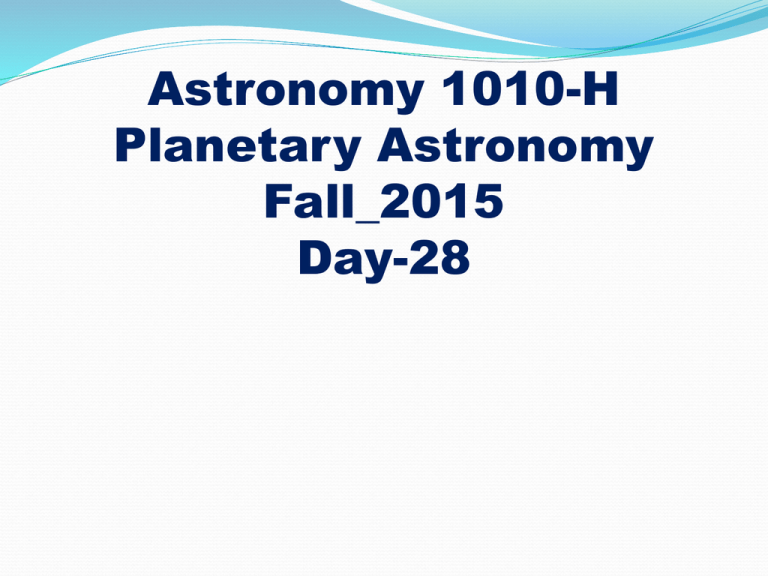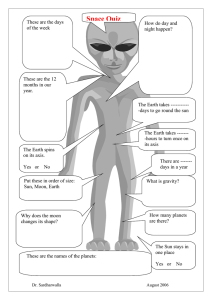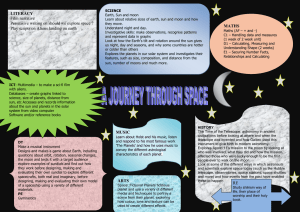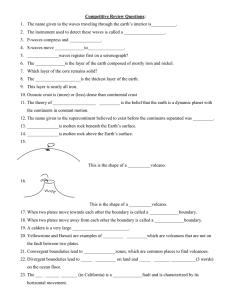Astronomy 1010-H Planetary Astronomy Fall_2015 Day-28
advertisement

Astronomy 1010-H Planetary Astronomy Fall_2015 Day-28 Course Announcements • How is the sunset/sunrise observing going? • SW-chapter 7 posted: due Fri. Oct. 30 SW-chapter 8 posted: due Wed. Nov. 4 • • • Exam-3 Wed. Nov. 4: Ch. 6, 7, 8 I will collect the L-T books on Monday, Nov. 23 Take more astronomy! Registration for the Spring semester starts soon so think about taking more astronomy. ASTR-1010/1011: Planetary Astro & lab (Tell your friends) ASTR-1020/1021: Stellar Astronomy & lab (Reg. + Honors) ASTR-2020: Problems in Stellar Astronomy ASTR-3010: History of Astronomy ASTR-3040: Intro. To AstroBiology PHYS-2468: Intro. To Physics Research ASTR-3030/3031: Instrumentation & Techniques Radioactive Dating Some elements can decay from one to another (e.g., uranium to thorium). These changes take place at known rates. Parent element declines, daughter element accumulates. Ratio of parent to daughter abundance gives the age of the rock. Age = time since rock was last molten. CONNECTIONS 8.1 Rock layers are formed through sedimentation. To find the ages of rock in these layers (or from Mars), scientists use radiometric dating. Parent particles decay into stable daughter particles at a steady rate. MATH TOOLS 8.1 A radioactive isotope decays to half its original amount in a half-life. We model the Earth’s interior by studying earthquakes. Seismic waves travel differently through different materials. Some waves are surface waves; others travel through. Primary waves travel through solids and liquids; they are longitudinal waves. Secondary waves go through solids only; they are transverse waves. Earth has a crust, mantle, and core (dense materials). Produced by differentiation in the early Earth: Dense materials sink, low-density materials rise. Current prevailing theory: Moon formed in large collision between Earth + Mars-sized protoplanet. The material collected to form the Moon. The composition of the Moon is like that of Earth’s crust. PROCESS OF SCIENCE Sometimes multiple hypotheses must be considered, though one might fit the data better than others. The Moon and the other terrestrial planets have interiors similar to Earth. Deeper in a planet means hotter and more pressure. Formation energy and radioactive material help to heat the interior. Smaller planets lose heat faster; large ones more slowly. MATH TOOLS 8.2 Large planets cool off more slowly than small planets. If we assumed planets all began with the same amount of radioactive material and that the successive decay produced all the internal heat, then the rate of energy loss is dictated by how much energy there is (volume = 4/3 π R3) and where the planet loses the energy (surface area = 4 π R2) . The amount of energy that could be lost divided by the area of loss is proportional to R/3, where R is the radius of the planet. Earth’s magnetic field acts like a giant bar magnet. It originates from processes deep in the interior that are not understood fully. Iron-bearing minerals tell us the orientation changes over time. Earth and Mercury are the only terrestrial planets with a substantial magnetic field. It is a puzzle why Venus and Mars do not have one. The Moon had one long ago. Concept Quiz Internal Heat What should be true about Earth’s internal heat? A. It is produced by the magnetic field. B. It would have been greater long ago when Earth was young. C. It currently is produced by differentiation. Tectonism is the deformation of Earth’s crust. Earth’s crust is broken into lithospheric plates. Continental drift and plate tectonics describe the movement of those plates. Crustal plates are moved around by convection—the rising and falling of hot/cold material. Earth has seven major plates and six smaller ones. Plates can separate or collide. Because of these motions, most volcanoes and earthquakes occur along plate boundaries. Only Earth has its crust broken into plates. All terrestrial planets have seen some form of deformation, though. Mercury’s surface shrank after it cooled, leaving cliffs. Mars has experienced extensive tectonism, and boasts the massive chasm Valles Marineris. Venus may have a different form of tectonism, with melting and overturning of the crust.






